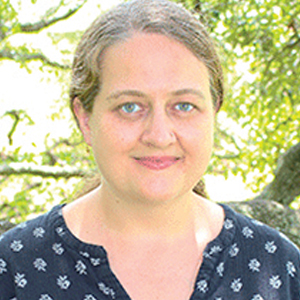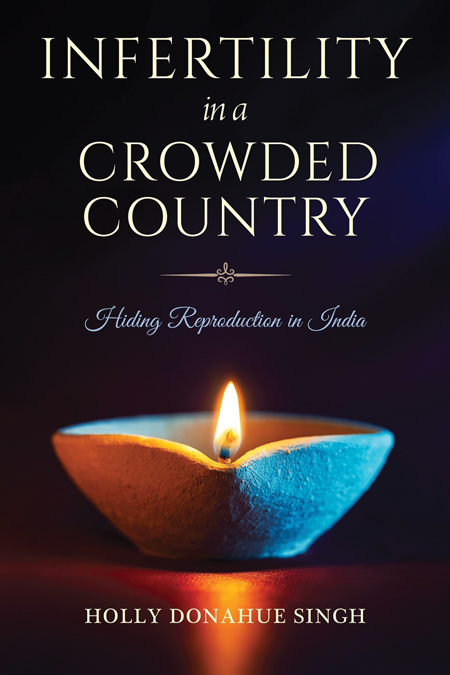Shedding Light on a Sensitive Subject

Holly Donahue Singh, an anthropology professor who teaches at the University of South Florida, has lived and done research in India. Her book, Infertility in a Crowded Country, published by Indiana University Press, draws attention to what is still a taboo topic in the world’s most populous nation. Well-researched and filled with evocative stories, it makes an empathetic case for addressing infertility in India.
In Shantaram, a stirring novel set in India, the author Gregory David Roberts describes the smells of Mumbai as “the worst good smell in the world.” I believe you first traveled to India in 1998 as a student of the Antioch Buddhist Studies program in Bodh Gaya, Bihar. How would you describe India—its singular sights, sounds, and scents—in a few words?
I think it’s actually impossible to sum up India in a few words! If I had to try, I’d say that, like Walt Whitman, it contains multitudes. I mean that not only in terms of numbers of people or the diversity of people, but of the abundance and richness of incredible and specific variety of sights, sounds, and scents that show one part of the amazing tapestry of human creativity and potential, as well as the traces that all living creatures leave on earth, the pleasant and the not-so-much.
The first time I landed in Delhi as a college study abroad student, I was thrilled and bowled over by the cacophony and newness of it. Now I would say that India, and especially Lucknow, where I’ve spent the most time, is one of a few places in the world that smells, tastes, and feels like home.
You went to Lucknow as a Fulbright Scholar with a research grant from Kenyon and lived there for extended periods. It is also where you met your future husband and became intimately acquainted with cultural mores. What drew you to the subject of infertility?
Yes, I first traveled to Lucknow during my second stay in India, where I lived in a university women’s hostel. While living there, I made friends with many fellow residents, students at all levels in the local university. We all talked over tea and meals in the mess, and Maggi and chai in our rooms and social spaces inside the walls of the hostel, about our dreams and apprehensions about the future. Many of them revolved around marriage, family, and careers. I would often ask whether they wanted to have children. The ways that people responded—mostly with blank stares, how could this even be a question?—helped me reflect more deeply and start to learn more about how we all inhabited the world. Over time, I began to wonder about what their lives and experiences might be like if infertility interrupted their reproductive dreams or desires.
 Please briefly describe your book for our readers. What challenges did you face while writing about a stigmatized topic? What feedback—or pushback—did you receive?
Please briefly describe your book for our readers. What challenges did you face while writing about a stigmatized topic? What feedback—or pushback—did you receive?
My book aims to show readers how people understand and cope with the challenges of creating and sustaining families. People inside and outside India have often taken high fertility for granted in India and have seen that as a problem for many decades. It’s a place where there’s been much more emphasis on convincing people to take measures to have smaller families than on helping people have bigger families. At the same time, people realize that infertility can have devastating consequences. I worked on the research and writing for this book for well over a decade, with the most intense fieldwork happening during one stretch of fourteen months in Lucknow: getting to know people with insight into fertility issues, making friends, networking, observing, interviewing people, and living with my in-laws.
I have heard many times from people in India that since India already has too many people, why help people make more? My response is generally a question—“Too many people for what?”—and a statement: Millions of people in India experience profound suffering due to their infertility problems, some of which could be alleviated through medical, social, and relational steps.
How do cultural and societal norms impact the experience of infertility, particularly in densely populated areas?
In densely populated places, there tends to be more policy emphasis on measures to reduce fertility. Showing images of families with one or two children in advertisements, textbooks, or films, for example, can also put additional pressure on people without children, that they are failing to meet societal expectations about making families that include children they can claim as their “own.” And that’s a place where culture and society matter. Which children count as your “own,” that’s something that’s locally defined. When people use less conventional methods for making families, such as assisted reproductive technologies like in vitro fertilization, or adopt a child, they have often tried to keep those details quiet, rather than to boldly declare the ways they’ve made their families. People who are at all familiar with contexts of Indian culture and familymaking could likely take stock quickly of their gut reactions to the options available, and those visceral responses can tell us a lot about what’s culturally taken for granted.
You boldly interweave the subject of religion in your exploration of involuntary childlessness. How does religion factor into the treatment of infertility? Did you observe any salient differences across the coexisting religions in India?
I found both commonalities and differences among people affiliated with different religions in Lucknow. Beliefs about appropriate reproduction and religious and legal regulations of divorce, remarriage or multiple marriage, and child adoption vary, and those create different options, opportunities, or threats, depending on one’s perspective. Some people would refuse particular treatments because those treatments, such as use of donor sperm, violated their sense of propriety from religious or cultural perspectives (and often both). Many people I spoke with could not even imagine infertile Muslims or infertile poor people of any religion, rendering their fertility struggles doubly invisible and vulnerable to being poorly addressed by existing systems. People from marginalized communities sometimes hesitated to access treatment from certain facilities because they worried not only about cost, but also about how they would be regarded there. And I did witness some harsh treatment of patients in clinical spaces. Across religions, many people also expressed concerns about paternity, lineage, and what people would say (log kya kahenge).
Did you come across any surprising or unexpected findings during your exhaustive research?
I found myself surprised all the time by the intimate, personal stories that people were willing to share with me, which often included navigating family disputes and enduring medical treatment at multiple clinics, at times alongside spiritual and other interventions. I was impressed by the defiant steps some people were willing to take, while creatively working to shield their actions from discovery. And the generosity with which people invited me into their lives, their homes, and their work and social spaces to observe, to listen, and to ask questions also surprised me.
Author of Kismetwali & Other Stories, Reetika Khanna is an Atlanta-based freelance writer who likes to spotlight people with purpose. She has worked with ELLE as a senior features writer, and as an associate features editor with ELLE DÉCOR, Mumbai. For more, go to ReetikaKhanna.com
Enjoyed reading Khabar magazine? Subscribe to Khabar and get a full digital copy of this Indian-American community magazine.
blog comments powered by Disqus










